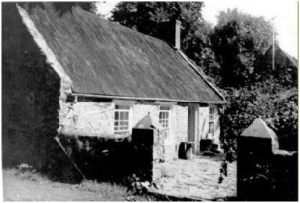John Vibert must have wondered what he had let himself in for when he arrived on Sark. Apart from stone from some old abandoned buildings everything else had to be shipped across from Jersey, which would have been quite some task in those days.
In common with the other 39 tenants, John’s tenement had an allocation of labourable land in the vicinity of where his house was to be built, together with other fields and an stretch of coastline. The latter was to ensure that all parts of the coastline of the island were protected from invasion.
John would have been required to pay a flat annual rental of one cabot of wheat per annum, which is not bad when you consider that one vergee of good land could yield 40 cabots per year, and he would have had about 30 vergees.
John’s tenement became know as La Rade and he built his house along what is now the main road of the island called La Rade De Moullin ( the road to the mill). The house would have been a simple single storey cottage facing south and was situated on the north side of his tenement. We know that by 1700 the house had been extended as it is recorded as having a frontage of 68 feet 6 inches at that time, which is much larger than the original would have been.
He must have been an intelligent man for in 1579 he had been appointed Sergente Ordinaire of the Sark Court, but he died circa 1612. On 24/12/1612 his tenement was inherited by his sons Nicholas and Francois. Nicholas who was the eldest took the house and one third of the land ( and with it the liability of providing the man for the island’s defence), and his younger brother Francois the remaining 2/3rds of the land.
Francois must have been quite successful because in 1597 he bought one of the other tenements now known as La Duvallerie from Jean De Carteret. In 1615 Francois’s daughter Jeanne married Samuel Duval and their son eventually inherited it and gave it it’s name.
Francois who had 7 daughters and no sons died in 1633 and his only surviving daughter, Marie inherited the 2/3 rds of the original La Rade tenement. She sold it on 1/12/1647 to Jean Le Gros Junior ( Who was at the time Captain of the Sark Militia) who was probably a relative. He in turn sold a portion of it known as La Touffe De L’Epine to John Vibert son of Pierre ( a member of a junior branch of the original John Vibert’s family), who built a new house on the land which became known as La Rue Cottage.
The house was also located on the main road to the mill, and was just a short distance from the original La Rade homestead. Records show that it cost him 50 silver crowns to build in 1649. The house had a frontage of 32 feet long and faced south, and the main gable was 19 feet wide. Regrettably the property was demolished in 1968 but a photo of the original property has fortunately survived and is reproduced above.
The main house and the 1/3 rd of land remained in the Vibert family until 1747 until it passed from the heiress Anne Vibert on her marriage to Pierre Maugier.
Nicholas, son of the original John Vibert, had a son john who acquired another tenement for the Vibert family in 1615 by virtue of his marriage to Marie Mahier, named Clos De La Ville. This was in addition to another he must have previously acquired named Clos Bourel. However from the court records it appears that he must have moved to Clos De La Ville, as the Clos Bourel property was allowed to fall into disrepair. We know this because in 1681 the Seigneurial Court ordered him to rebuild the Clos Bourel house. Records show that the property measured 31 feet 6 inches by 19 feet. This property passed to his daughter Marie who was married to Abraham Guille, and it remained in the Guille family until 1850.
Well, that’s all I know for now folks. More will be added when further research has been done.


Recent Comments